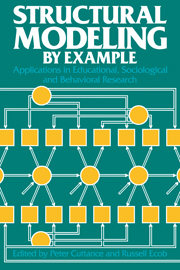Book contents
- Frontmatter
- Contents
- Preface
- List of contributors
- 1 Introduction
- 2 An overview of structural equation modeling
- 3 Field dependence and the differentiation of neurotic syndromes
- 4 High school seniors' reports of parental socioeconomic status: black–white differences
- 5 Modeling the hierarchical structure of learning
- 6 A study of longitudinal causal models comparing gain score analysis with structural equation approaches
- 7 Some structural equation models of sibling resemblance in educational attainment and occupational status
- 8 Applications of structural equation modeling to longitudinal educational data
- 9 The robustness of maximum likelihood estimation in structural equation models
- 10 An inquiry into the effects of outliers on estimates of a structural equation model of basic skills assessment
- 11 Testing structural equation models
- 12 LISREL models for inequality constraints in factor and regression analysis
- 13 Issues and problems in the application of structural equation models
- Appendix
- Glossary
- Index
8 - Applications of structural equation modeling to longitudinal educational data
Published online by Cambridge University Press: 12 January 2010
- Frontmatter
- Contents
- Preface
- List of contributors
- 1 Introduction
- 2 An overview of structural equation modeling
- 3 Field dependence and the differentiation of neurotic syndromes
- 4 High school seniors' reports of parental socioeconomic status: black–white differences
- 5 Modeling the hierarchical structure of learning
- 6 A study of longitudinal causal models comparing gain score analysis with structural equation approaches
- 7 Some structural equation models of sibling resemblance in educational attainment and occupational status
- 8 Applications of structural equation modeling to longitudinal educational data
- 9 The robustness of maximum likelihood estimation in structural equation models
- 10 An inquiry into the effects of outliers on estimates of a structural equation model of basic skills assessment
- 11 Testing structural equation models
- 12 LISREL models for inequality constraints in factor and regression analysis
- 13 Issues and problems in the application of structural equation models
- Appendix
- Glossary
- Index
Summary
Introduction
My objectives in this chapter are the following:
To analyze data on learning difficulties and reading collected over a period of two years using the so-called two-wave model (Rogosa 1979; Plewis 1985) and to test a number of hypotheses concerning the relation of learning difficulties to progress in reading the relation of reading attainment to changes in learning difficulties from one year to the next.
To investigate the effect of different estimates of the reliability (or, equivalently, measurement error variance) of the reading test, given in the first year, on the relationships between reading and learning difficulties over time.
To analyze data collected during a three-year period by means of a “three-wave” model to investigate systematically the stability over the years of the measurement properties of the scales and of the structural aspects of the model, as well as to test various forms of restrictions on the model that are determined by particular substantive questions.
To examine the influence of the child's gender and of the father's social class on the relationships in the two-wave model. Both gender and social class have been shown to be important determinants of learning difficulties, both in these data and in other studies.
In the multiple-group model of LISREL the influences of the child's gender and father's social class, which are exogenous variables in the model, are partialed out in order to ensure that the relationship between attainment and learning difficulties is not an artifact of their common dependence on gender and social class. In addition, I test whether the relationships in the model are the same within each combination of gender and social class categories.
- Type
- Chapter
- Information
- Structural Modeling by ExampleApplications in Educational, Sociological, and Behavioral Research, pp. 138 - 159Publisher: Cambridge University PressPrint publication year: 1988
- 1
- Cited by



